
It’s hard to get through a conversation about online marketing right now without bringing up Google, Facebook, and Yahoo (among other popular companies). However, if you’re not heavily involved in online marketing, and you’re not close to the actual referring traffic numbers from Google, Yahoo, and Facebook, then their influence can easily become nebulous. It’s easy to say, “Google is a powerhouse” or “Facebook has 325 million members”, and “You need to be there”, but how powerful are they really?
From a traffic perspective, the three companies are so powerful that I’ve given them their own combined name, or FaceYahoogle. The power of FaceYahoogle ends up becoming very real for my clients after I complete a competitive analysis (which includes identifying major sources of traffic for their company, as well as their competitors). The numbers I present across websites typically show extremely high referral data from FaceYahoogle, and by viewing the actual traffic numbers, you start to get a feel for how much impact the three entities have traffic-wise and potentially revenue-wise.
Digging Deeper into FaceYahoogle
If you’ve read previous posts of mine, then you already know that I’m a big believer in using data versus opinion to make decisions. The power of analytics in online marketing enables you to see granular performance data across a number of key metrics. And the more websites I analyze, the more I see a significant trend across industry categories. I see FaceYahoogle sending large amounts of traffic to a wide range of sites. The abnormally high percentage of traffic coming from Google, Yahoo, and Facebook is not only amazing to see, it’s actually scary. With thousands and thousands of potential referring sites on the web, to see FaceYahoogle send that high of a percentage of traffic is alarming. I think you begin understand how Google built up a $22 billion war chest! :)
I think many people would suspect Google being high on the referring sites list, based on having ~70% market share in search and also having Gmail, Google Maps, Google Docs, etc. However, I’m not sure many know how much actual traffic is coming from Googleland. Also, we hear that Facebook has over 300 million members, which is powerful, but are those members visiting your site via the social network? I’ll answer that question below via screenshots. And then you have Yahoo, with turmoil somewhat cloaking the power of its sites. How much traffic actually comes from Yahoo Search, Yahoo Mail, Yahoo News, Finance, Answers, etc?
So that’s my quick introduction to FaceYahoogle. Now let’s take a look at some numbers! I have provided Compete data (September 09) for a number of popular websites across a range of categories so you can view their referring sources. Note, I know Compete isn’t perfect, but it does provide a wealth of information to analyze for each website (especially for sites that receive large amounts of traffic).
Referring Sites for NYTimes.com
31% from FaceYahoogle (and 17% from Google alone…)
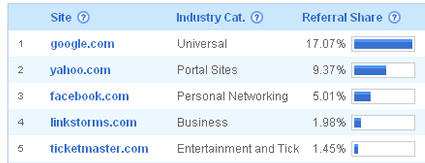
Referring Sites for LinkedIn
36% from FaceYahoogle, and over 8% from Facebook.
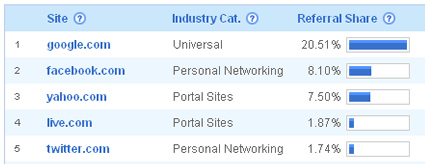
Referring Sites for Weather.com
24% from FaceYahoogle
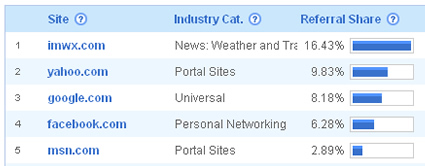
Referring Sites for JCrew
31% from FaceYahoogle
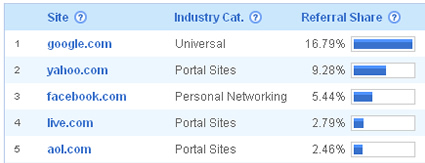
Referring Sites for The Huffington Post
33% from FaceYahoogle (and almost 8% from Facebook)
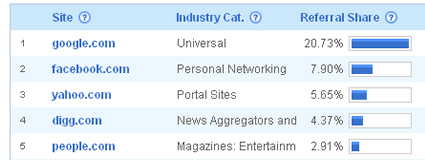
Referring Sites for Yelp
A whopping 55% from FaceYahoogle (and 43% of that from Google!)
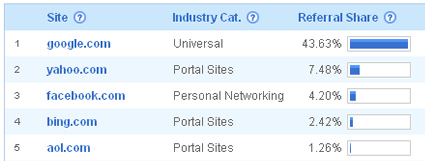
Referring Sites for ESPN
25% from FaceYahoogle (and nearly 10% from Facebook)

Referring Sites for Amazon.com
25% from FaceYahoogle (cha-ching…)

Referring Sites for Apple.com
28% from FaceYahoogle
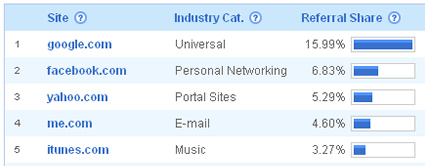
Let’s throw in a military site to see how the 3 headed monster works here:
Referring Sites for AirForce.com
Over 40% of referring traffic from FaceYahoogle
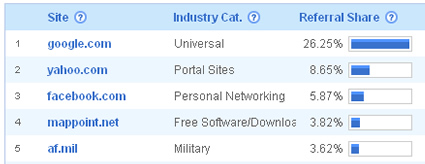
The screenshots above make it a little more tangible, right? FaceYahoogle is accounting for 40%+ of referring traffic for some websites. If you analyze website traffic often, then you know how insane those numbers are… But that’s not the whole story. The downstream data is important too. It ends up that a large percentage of traffic from these websites is going back to FaceYahoogle. Let’s take a look at just a few from above.
Downstream Data for Apple.com
26% of visitors leave Apple.com and go back to FaceYahoogle
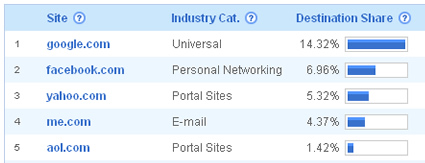
Downstream Data for AirForce.com
31% of visitors leave Apple.com and go back to FaceYahoogle
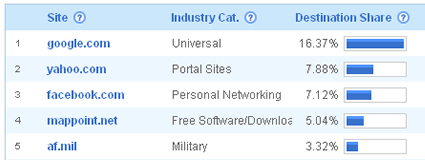
I saw the same trend across the other sites.
So, FaceYahoogle is driving enormous amount of traffic, but it’s also the top recipient of traffic from many sites. In particular, Facebook provides some unique opportunities with regard to downstream traffic. Give your visitors something to take back and you can possibly end up with even more traffic (WOM-based or possibly viral-based). And with some Google and Yahoo traffic going to back to Gmail, Yahoo Mail, Yahoo Answers, etc., you also have opportunities for spreading the word about your products, company, brand, etc. Let’s quickly take a closer look at each part of FaceYahoogle below.
Google
As you can see, Google is an absolute powerhouse, even showing 43% of Yelp’s overall referring traffic. That’s outrageous! And it’s not just any traffic, right? Many of the visitors from Google just searched for specific products or services that each site provides (AKA, high quality visitors). Imagine the revenue impact of Google traffic for those sites. In case you are wondering, Google traffic numbers include Search, Maps, Mail, Docs, Video, etc.
Seeing the high percentages from Google across sites, you can start to understand why SEO and SEM have been incredibly hot in online marketing… Some companies survive based on Google traffic alone (via paid and organic search traffic). A slip in rankings can be catastrophic for some websites, with the potential of impacting millions of dollars of revenue. Think about it. If you have 40% of your traffic coming from Google and slip to page two, three, or beyond, you will lose many targeted visitors, and the money they would have spent on your site. So is Google powerful? You bet it is. The numbers combined with my experience tell me so. :)
Facebook
Facebook has grown by leaps and bounds over the past few years and is estimated to have 325 million members now. Clearly people are signing up in droves, using the platform at a staggering pace (104 billion pageviews based on Compete September 09), and oh yeah, they are visiting websites from Facebook. As you can see in the screenshots above, Facebook ranks in the top five referring sites for many of the properties I checked. Actually, it was typically in the top three. And in case you’re wondering, Twitter is moving up the charts too. Depending on the focus on the site in question, I see Twitter sending large amounts of traffic (and that doesn’t count desktop clients which many Twitter members use). On that note, to read an example of how Twitter can impact exposure, traffic, and subsequent SEO power, check out my post about the Twitter effect on SEO. It’s a great example of how Search works with Social.
So, if your company is ignoring social media, then go back through the screenshots above and take note of the percentage of referring traffic from Facebook again. In meetings, I find myself saying more and more that if you ignore social media (and especially Facebook and Twitter), do so at your own risk. Again, the numbers are pretty convincing.
Yahoo
Although Yahoo has taken a back seat recently, the numbers are still strong from a referring source perspective. Between Yahoo Search, Yahoo Mail, Yahoo Answers, Yahoo News, Finance, etc. there are still millions of people visiting each property per month. And yes, those sites end up as top referring sources (impacting traffic, sales, sign-ups, twitter followers, Facebook fans, etc.) Yahoo consistently showed up in the top five referring sites, and often number one or two. Don’t count out Yahoo just yet. If you do, you’d be dismissing a huge traffic source (when you take all of their properties into account).
The Future of FaceYahoogle
I’m sure you are wondering which sites will be the major sources of traffic in 2010 and beyond? Will Twitter beat out Facebook, will Bing surpass Google, will Yahoo be non-existent? The beauty of the web (and technology) is that we never know. But the data does tell us something… don’t ignore Search and Social, and how they can work together.
People are searching and people are talking. And the people that are talking can impact how people that are searching find your website. And people searching can lead to sharing on social networks, based on what they find. Look at the numbers again. Don’t discount Facebook because you think people are tagging photos or playing games all day. You also shouldn’t disregard Google’s dominance. It is too powerful to ignore. And Yahoo isn’t dead yet. There are millions of people visiting Yahoo Sites on a regular basis.
Last, to emphasize that we never really know what will take off, I have provided Twitter’s trending below (Compete data over the past 24 months). I bet many people don’t even know that it was around in 2006 and 2007… and that it crept along until 2008 when it gained serious traction. So, is the next Twitter out there right now slowly growing and about to gain traction? Good question. :)

GG
